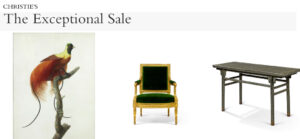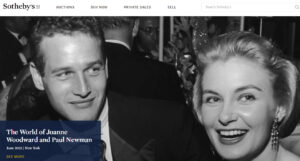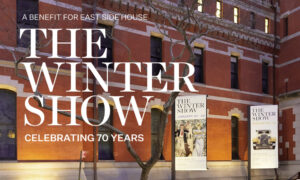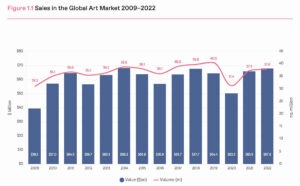Art Market Reaches Heights

Big changes happened in the art and furniture auction market these past three months as the LONG TAIL of COVID evaporates. Furniture now stands frozen in the headlights while the market currently attempts to offer great pieces to elite buyers. Auction houses did phenomenally well these past two years because patrons learned to use the computer to BID, yet customers bought art, not furniture.
From 2000 to 2023 the antique furniture market dropped DOWN eighty percent for sales of good to great pieces, such as up-market French and English 17th and 18th century furniture. That drop in value indicated to the “big players” (Sotheby’s and Christies) that they needed to shift their marketing strategy for fine furniture. They realized their ultra-wealthy clients desired ONLY “exceptional” objects. So instead of marketing a piece for its qualities, such as period and style, they marketed a piece as a one-of-a-kind RARE object. They liberally used the word “exceptional” to identify both a piece of furniture and its “discriminating” prospective owner.
The Best of the Best

Sellers now target Ultra-wealthy clients to purchase the finest pieces of furniture, regardless of period, category, or origin. Gone are the designated “period” sales, in which, for example, they offered French Louis XV furniture. Today all eras are grouped together; for example, Christies’ The Exceptional French Sale. A Christies representative said, “We instituted the ‘Exceptional Sale,’ offering the best of the best in ANY genre, meaning any genre and any period, just the best…and of the higher auction estimate.”
 The Exceptional Sale is keyed to an exceptional collector, who, more than likely, is a celebrity. Not surprisingly celebrity buyers LOVE to buy from a celebrity collection because “celebrity owner” provenance increases an object’s value. Sotheby’s and Christies found great success with sales of the estates of Mellon (2014), Getty (2022), Saint Laurent (2009), Givenchy (2022), and Rockefeller (2018). They have no qualms about using photos of these celebrities to sell their furniture and art. Everything in one MANSION goes in ONE sale.
The Exceptional Sale is keyed to an exceptional collector, who, more than likely, is a celebrity. Not surprisingly celebrity buyers LOVE to buy from a celebrity collection because “celebrity owner” provenance increases an object’s value. Sotheby’s and Christies found great success with sales of the estates of Mellon (2014), Getty (2022), Saint Laurent (2009), Givenchy (2022), and Rockefeller (2018). They have no qualms about using photos of these celebrities to sell their furniture and art. Everything in one MANSION goes in ONE sale.
ONLY the best of the world’s antique furniture and decorations sell to a handful of wealthy buyers. Those buyers represent a miniscule percentage of possible buyers and a VERY low percentage of Sotheby’s or Christies’ income. The less “exceptional” pieces of fine furniture do not sell well and the upper to middle level market remains flat. In contrast, the ART auction market continues to blaze. Sotheby’s in 2021 made $7.3 billion, the highest earning in 277 years.
 The Winter Antiques Show, a fixture in NY for all connoisseur furniture buyers since the 1920s, includes art, furniture, and decorative arts. In concert with their board of directors they changed the definition of “antique” and revised their rules of what eras and periods they will show. In 2009 their board of directors redefined an antique as sixty years old, previously the definition said a hundred years or more. This year the definition of antique became an object of ANY AGE. Anything of quality can be entered in the Winter Antiques Show. To call a piece antique is no longer a ‘selling point.’ By the way, they renamed the show The Winter Show.
The Winter Antiques Show, a fixture in NY for all connoisseur furniture buyers since the 1920s, includes art, furniture, and decorative arts. In concert with their board of directors they changed the definition of “antique” and revised their rules of what eras and periods they will show. In 2009 their board of directors redefined an antique as sixty years old, previously the definition said a hundred years or more. This year the definition of antique became an object of ANY AGE. Anything of quality can be entered in the Winter Antiques Show. To call a piece antique is no longer a ‘selling point.’ By the way, they renamed the show The Winter Show.
 Union Bank of Switzerland, whose clients include celebrity investors, publishes the USB Art Market Report yearly. Their 2022-2023 analysis just came out showing turbulence rocked the art world. Inflation fears, the long tail of COVID, supply chain issues, and crypto issues produced volatility. Many areas of investing did poorly, but not the sales of high end art. Art sales at the main auction houses went up three percent, in spite of volatility.
Union Bank of Switzerland, whose clients include celebrity investors, publishes the USB Art Market Report yearly. Their 2022-2023 analysis just came out showing turbulence rocked the art world. Inflation fears, the long tail of COVID, supply chain issues, and crypto issues produced volatility. Many areas of investing did poorly, but not the sales of high end art. Art sales at the main auction houses went up three percent, in spite of volatility.
Mergers in the Auction World and Private Galleries
Smaller to mid-sized auction houses banded together and merged this past six months. David Rago Auctions merged with Wright Chicago who merged with Los Angeles Modern Auctions. Bonhams and Skinner merged. The auction market grows larger while small local galleries survive because they capitalize on exciting social events, such as opening night parties. Local galleries use their spaces for other events besides show receptions. In fact the entire Art World is again event-centric: “The Biennale,” “The Exceptional Auction,” “The Winter Show.” These events encourage like-minded socially inclined patrons and exploit the social side of buying art.